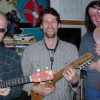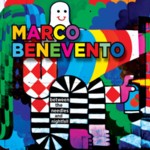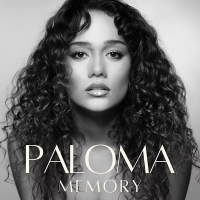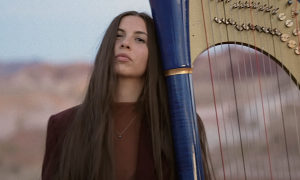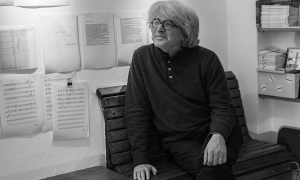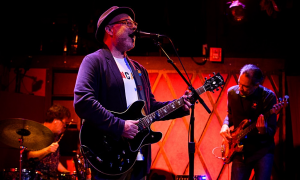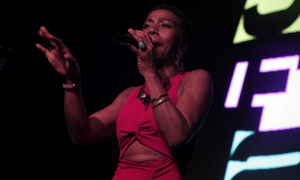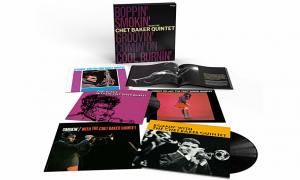Home » Jazz Articles » Interview » Steve Norton: Debris and Beyond
Steve Norton: Debris and Beyond
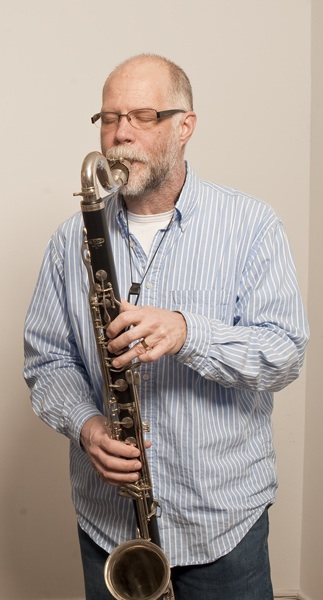 Multi-reedist Steve Norton is best known for his work with the 1990s Boston-based band Debris. Debris was an ambitious, exuberant, puzzling band that puzzled together serialism, free jazz and funk. Their music is in equal measure exhilarating and exhausting.
Multi-reedist Steve Norton is best known for his work with the 1990s Boston-based band Debris. Debris was an ambitious, exuberant, puzzling band that puzzled together serialism, free jazz and funk. Their music is in equal measure exhilarating and exhausting.
It was the combination, in part, that burned Norton out about ten years ago, as well as a need to attend to his job and family. Back in full force now, at fighting weight, with drive and direction and reinvigorated sound, he's steaming.
Recent projects include the duck-call trio, Duck That, with Joshua Jefferson and Angela Sawyer; Matt Samolis' Metal and Glass Ensemble; a trio-without-name performing a stunning rendition of Steve Lacy's "Tips," with Noell Dorsey on voice and Samolis on flute; and a duo with Vic Rawlings, Symptomatic.
Symptomatic is, in fact, symptomatic of a theme Norton has pursued throughout his career, the play between paying attention to collaborators and blissfully ignoring them in a way that will lead to discovery of deeper layers.
All About Jazz: I know that your group Debris employed a lot of structure, but when I hear it—and like I said, I know this isn't accurate—but I think of it as an avant-jam band.
Steve Norton: Really...I could almost take umbrage at that. But I won't! For the most you will find that the pieces on the discs, they've all got—there's generally a bunch of written stuff and then there's areas for improv. So there's plenty of improv in there, but it's always within a context. It's kind of like with traditional jazz where you have the head and then a bunch of solos, except it doesn't really work like that. Frequently the written music is something that's episodic and through-composed, so it's not like we just start with something and end with it: we start with something, there'll be some improv, another written section—a different written section will come in, there'll be more improv, and then a another written section which is yet again different...So you won't hear that kind of repetition most of them time.
AAJ: And the tone rows...
SN: Yeah, almost all the pieces composed by me on those discs are twelve-tone.
AAJ: I have a theory. You know Harold Bloom's theory of the anxiety of influence?
SN: I've heard of it, I've never heard it articulated.
AAJ: It's an Oedipal struggle between a poet or an author and his precursor, like Wordsworth and Milton...I see your precursor as being Eric Dolphy, and you've been wrestling with Dolphy for twenty years, trying to throw him off, and you've finally done it.
SN: [laughs] Wow, that's funny. So I would accept him as a precursor...On my way here I was remembering a very important evening in the process of my development. This must have been in 1979 or '80. I had a good friend, she lived on Hanover Street [in Boston's North End], three or four floors up somewhere, and she went away, and she asked me if I would come in and feed her cat. This was back when I was living at home in Framingham.
So I drove in, it was like a Sunday night and I came in—I was just happy to be in the city and it was nice out and I opened the windows, and I fed the cat and then I just sat there and I turned the radio on. And I just sat there and listened to something from one of Dolphy's Prestige releases—Out There or Outward Bound (both 1960)—and I can't remember which piece it was, but I loved it and I wrote it down; and the same night I heard Miles Davis—it was "Moon Germs," off The Birth of the Cool (Capitol, 1957). And there's a section in "Moon Germs" where—it's not a fast piece, it's a fairly slow piece—and the time goes away, and the horns are playing these sustained chords, and they sound almost atonal. They're almost Schoenbergian, and I was just smitten by that. That was the first time knowingly hearing either of those guys, and thinking, "That was really cool."
I appreciated jazz, but I wasn't really hooked on it...But I had this—I was always looking for things that were interesting, and more interesting, and I ended up finding Roxy Music—
AAJ: I can hear Roxy Music in your work.
 SN: No question. Brian Eno's solo records...and then the next thing you know, Fred Frith and Henry Cowell. And I was on my way out there. I always had this feeling, this kind of push, to hear things that were unusual...I worked at Strawberries, the record story in the late '70s and I was really attracted to the Anthony Braxton album, The Montreux/Berlin Concerts (Arista, 1977), 'cause it had that picture of him playing the contrabass clarinet, and I was like, "What the hell is that!"
SN: No question. Brian Eno's solo records...and then the next thing you know, Fred Frith and Henry Cowell. And I was on my way out there. I always had this feeling, this kind of push, to hear things that were unusual...I worked at Strawberries, the record story in the late '70s and I was really attracted to the Anthony Braxton album, The Montreux/Berlin Concerts (Arista, 1977), 'cause it had that picture of him playing the contrabass clarinet, and I was like, "What the hell is that!"
I had been playing music all my life. I took violin in the third grade, piano in the fourth, I played piano for twelve years. I had a friend in high school, he was a guitarist, and without really knowing anything about free improv—by that point I had been listening to Yes and Genesis, because it was unusual. And he and I started to improvise, because it seemed like the thing to do. I think the stuff we were playing was mostly rock based, chordally and rhythmically, but it always went in strange places and there was never any plan. One summer evening we pulled all the stuff out of the kitchen cupboards, pots and pans, and started playing them. We decided we had to play the kitchen! And recorded it.
AAJ: Did you play rhythms when you were doing the pots and pans, or did you just bang on them randomly?
SN: There were rhythms, we would sort of get into grooves, but it was—it shifted. It shifted a lot. At that point I don't think I'd actually heard any free improv, I wasn't aware of Derek Bailey or Evan Parker. A year or two later I stumbled upon a copy of one of the Evan Parker/John Stevens The Longest Night discs (Ogun)—I found one in a used record store in Cambridge. That was unusual. I think at the time I bought it, it was a little more than I was ready for. But at the same time, I was also getting interested in classical music. I was taking music theory classes in high school. My high school had a really good music theory program. In two years we got through the whole Walter Piston harmony book.
 Duck That, from left: Steve Norton, Josh Jefferson, Angela Sawyer
Duck That, from left: Steve Norton, Josh Jefferson, Angela Sawyer
AAJ: I know that Dolphy's two favorite composers were Webern and Debussy, so there's the twelve-tone again.
SN: When I was at Berklee, I was a composition major, and I took a class with Greg Fritze, who's a tubaist, and he's now the head of the comp department—but he introduced me to Webern, and I was just totally smitten. And Berklee was an interesting place to study composition. I don't know how aware you are of the academic controversies of the '50s and '60s, but the controversies are still being played out. Basically the serial avant-garde took over the big writing academies, like Julliard and Columbia and Princeton, and things—to read about it things became very dogmatic: you can't write this way, you have to write that way. By the time I got to music school, I think that stuff had largely played itself out.
And at Berklee, traditional composition was an afterthought. I think there were twelve students in the major. I think I hit it at its nadir. Not a lot of people were paying attention to it. There was nothing dogmatic about it. I took a class on the Beethoven quartets, on Bartok, and on Sibelius. You can't get any less academic and dogmatic than Sibelius...But when I stumbled across the Webern I was just smitten, and he's still one of my favorite composers.
AAJ: Webern would have been a favorite of these dogmatic types.
SN: Absolutely would have. Webern begat Boulez, and Boulez is—
AAJ: The old curmudgeon.
SN: The guy, the guy with the big hammer! Le marteau. So, basically it all kind of got blamed on Webern but I think that's a wrongheaded way of looking at it. It wasn't Webern's fault, it was the academics that seized upon what they thought was the truth. I was just doing it because it was something that worked for me. I sort of took to twelve-tone writing very naturally. It made me very happy. I just liked it. I found it a very enjoyable way to work.
AAJ: I think we should discuss Debris more, because that's your most well known project.
SN: Sure. Let's see. What do you say about Debris? It was—
AAJ: Difficult, exuberating, grating—
SN: More music that nobody likes [laughs]. You, know, one of the things that strikes me about the entire experience, is the constant experience of people coming up to you afterwards, and sort of look at you quizzically, and say, "I really liked it, but I don't think I understood it." It made me think a lot. It's a topic I've been thinking about most of my musical life, and it's like, "What does it mean to understand music?" And I think there's this whole, furrowed brow, "it's all very technical" and you have to understand. It's like, "Really? There's nothing to understand. It's just sound."
AAJ: That's what Greg Kelley was saying when I interviewed him. He wants to leave a door open for the listener to find his own meaning in the music.
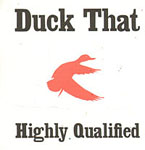 SN: That's the only meaning that exists. Right? The only meaning that exists in music is the meaning between the listener's ear. And that meaning's informed by their culture and their upbringing, and all the music they've listened to before that, but there's no code, there's no secret message in there. Just because you don't know where the tone row is, that's no more important than knowing that this folk song ended on a 5 chord.
SN: That's the only meaning that exists. Right? The only meaning that exists in music is the meaning between the listener's ear. And that meaning's informed by their culture and their upbringing, and all the music they've listened to before that, but there's no code, there's no secret message in there. Just because you don't know where the tone row is, that's no more important than knowing that this folk song ended on a 5 chord.
AAJ: Anything more about Debris?
SN: I think we just went tangential on one of my favorite topics. I think one of my favorite topics is, the way music is constructed in our culture, and the way people are sort of taught— there's specific roles, there's musicians, then there's mere mortals, that sort of thing, so to a degree it's kind of a priesthood. Like you can't really talk about music unless you've developed a type of jargon, otherwise your opinions aren't any good. There's this whole, "Do you understand music, or not," and if not, you shouldn't talk about it. And we're also taught to construct our opinions as facts. "This is great music"—it's not great music, it's music that a lot of people agree that they really like. So we're steered strongly away from our own subjectivity. And we're taught that subjectivity is not valuable, it's mere opinions. In fact, art is completely constructed in the subject. And that's all we've got, and we ought to learn to take our subjectivity seriously.
AAJ: There's a time-capsule mentality. If you had ten people to put in a time capsule, who would they be—and of course, Beethoven...
SN: Yeah, because that's "great." And it's only great because enough people have decided to agree that they would say it's great...There's a lot of skill involved, there's also a lot of, completely intangible something involved, and because you can't quantify that you don't really want to talk about it. Instead of accepting that there's this strong subjectivity—I think people are afraid of that. It's warped the way people think of art in general.
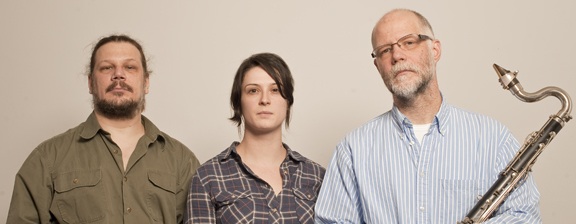 Tips, from left: Matt Samolis, Noell Dorsey, Steve Norton
Tips, from left: Matt Samolis, Noell Dorsey, Steve Norton
AAJ: Can it be otherwise?
SN: Well, I think it is otherwise in other cultures. The art object as saleable investment is not solvable inside of capitalism. I think it's confused, but I'm not sure what can be done about it. It would be nice to see some sort of aesthetic education in the educational system, but of course the educational system is busy turning out employees. So it's not going to get solved there. It seems to be that only the people that think really hard about this stuff ever get anywhere near it. John Cage notwithstanding.
I think John Cage did an enormous amount to get people thinking about art as something other than this syndrome I've been describing. He basically wanted to stop people from thinking of art as objects. He said, "I'm not making objects, I'm building processes. I want the music to be very plainly the product of a process..."Improv is that way to a degree, I think some more and some less, but it's very process-y, it's ephemeral, it hopefully makes people think about the moment, rather than investing in the future.
AAJ: So you are touching back on Debris, in the way that, you see it as a process, maybe?
SN: Sort of, yeah. Particularly because we were composing I think it was only partially there, but what the focus of the group was, was getting the balance between the composed and the improvised and trying to literally make it balance out, so that each part had equal weight. On many occasions I kept trying to get the band to improvise freely, and we would do it occasionally, but for the most part I think the band was at its strongest when it was focused on the whole composition and improvisation at the same time.
AAJ: How did the improvisation relate to the composition?
SN: in various ways. With some of the twelve-tone pieces we would actually put up the matrix that contained the whole pitch set for the piece, and use it to improvise. A matrix is a grid, of twelve notes by twelve notes, it's just a row and we just used letters. You have the prime row, straight across the top, and you would take, starting on the first note you would take the inversion of the prime row, and spell that down; so that's a series of notes in the column, going down...With each note in that row going down, you would start a transposition of the prime row going across.
So you basically have the prime row, in twelve keys, the inverted row in twelve keys, and then if you read the prime row backwards, you'd have the retrograde prime row, and if you read that up and down you'd have that in all twelve keys. And you do the same for the inverted row, you read it backwards and you get the inversion in all twelve keys. So you have this box of 144 notes, and they go in a certain order. And those are basically all the available inversions and transpositions of the row you selected to base your piece on. This is sort of standard Schoenbergian twelve-tone writing.
AAJ: So that's what you would base your improvisations on?
SN: Yeah, so instead of putting up the chart with the melody and the changes, we would put up the matrix for the piece we were working on. And we didn't do that all the time, but we did it for a bunch of pieces, and that was a fairly standard approach. So it went from that sort of attempt to lock the improvisation into the composition, to freer use of motives, to completely just free associating.
AAJ: What about funk and rock and elements?
 SN: Rhythmically, the band was more comfortable there than in jazz. Because the background of the players was there. We were a bunch of suburban white kids. Rock and roll was in our blood from the beginning. I think that's how we arrived there. It wasn't really all that conscious, it's just that when we were writing that's pretty much what came out.
SN: Rhythmically, the band was more comfortable there than in jazz. Because the background of the players was there. We were a bunch of suburban white kids. Rock and roll was in our blood from the beginning. I think that's how we arrived there. It wasn't really all that conscious, it's just that when we were writing that's pretty much what came out.
When I first joined Debris I was actually in Either/Orchestra.
AAJ: With Russ Gershon?
SN: Yeah. That was the first playing-out band I had ever played in. I was Russ' first recruit. He figured, once he found a baritone player the rest would be easy. I was with the group for about a year and a half, almost two years. I'm on the first record, and I think I'm on a little bit of the second record. But I left—it was fairly mutual—he had found Charlie Kohlhase, who was a far better fit. He needed more jazz soloists. I was not a jazz soloist. I could play the instrument, I could play the charts—I was never a great jazz soloist. The whole blowing-over-changes thing did not—it wasn't in my gut. I sort of tried half-heartedly to do it while I was at school, but it just wasn't how I wanted to play. Which is good, because then I would be very sad!
AAJ: I'm trying to remember when I first met you. Was it a year or two ago?
SN: Was it Grizzler?
 AAJ: Yeah. It was a Grizzler show. You were throwing the reeds on the ground!
AAJ: Yeah. It was a Grizzler show. You were throwing the reeds on the ground!
SN: I had been doing that since Debris. We had some gigs up in Bennington, VT, which had this art gallery. It was an old mill building, beautiful hardwood floors, and when you drop stuff it really sounds great. There was some really expansive improv going on, and I inadvertently dropped some reeds on the ground, and I thought, "That sounds great..." And in that same building I also found some duck calls, and that's also something I've been doing for a while.
AAJ: Was it Dave Gross who brought you back into the music, after your hiatus?
SN: I had pretty much played at one gig a year, from 2001 to 2007. I played with Matt Samolis more than anyone else during that period. Matt and I did a lot of photography together, in the early 2000s. But occasionally we would play as well. In March/April 2008 he asked me to do some Metal and Glass Ensemble shows.
It was very drone-y. Matt has a steel cello. There's a steel bracket with a big sheet of stainless, across the front that's a resonator, and there are cymbals, big ride cymbals, and these long, steel rods, bolted to the bracket, and he uses these big, heavy bows that he builds, and you bow the thing, and it creates this roar, that's just amazing sounding. And he's been working on that for 15-17 years.
In the mid-2000s he started building an ensemble around that. The other component were these sets of tuned wine glasses, where they're tuned to a set of justly tuned intervals, and there's several of these. It's like a terraced set of plywood with the glasses nepoxied on to them, and they're big, with thirty glasses on the thing. So there's a couple of people playing glasses, a couple playing bowed metal, and there's people playing instruments that can drone, basically.
I joined that playing bass clarinet, working out the long tones, the circular breathing, just coming in and playing the same note for seven minutes, and that really appealed to me. It was something I wanted to get better at...The instruction to the instrumentalists, is "Join in a subtle fashion, don't crash in," and basically the goal is to make a large, group voice. So you sneak in quietly with your entrances and you get your pitches from the glass or from the metal. And you just make this big sound. And once in a great while someone will step forward and do something melodic and soloistic, and generally you then recede back into the ensemble voice.
AAJ: Is it anything like gamelon music?
SN: Except that it's absolutely not rhythmic. The intent is that it's very much a sustained sound. There's a couple of percussionist who've done gigs with us, but the goal with the percussionists is not to do rhythmic or time-based or tempo. He'll sort of roll on a gong. It's all about swell and this sort of single-ensemble voice.
So that's where I stared playing, so I had done three or four gigs with that group in 2008, and then one day in September Dave Gross sent me an e-mail saying, "I'm putting together another improvising large ensemble and I want you to play bass clarinet and baritone. Are you in." And I was just like, "Yup, gonna do it." And one thing has led to another. At the very first gig, that is where I met Joshua Jefferson. And I had talked to Angela Sawyer before, but I'd never played with her before. And when I got there, I had brought my baritone, and my bass clarinet. And I had brought my bag of game calls, but I didn't pull it out because I didn't think I'd use it. But then Josh opens up his case, and he's got a couple game calls in there. Angela opens the big pink suitcase and she's got a boatload of game calls in there! And I was like, "Wait a minute!" And I went and got my case and I opened it up and we're like, "We should do a trio." And it was a couple of weeks after the first Grizzler gig that Duck That was born, and that band is just so much fun.
AAJ: The blending of the serious and the comic is very fine.
SN: Right. And you've really hit the nail on the head. Our mission statement is, "Bringing funny sounds to serious improv."
AAJ: And I really admire Angela, without having any serious musical training, just by being a listener...
SN: She's a fantastic listener, she's incredibly smart, and she's a great improviser. And another thing I've been thinking about a lot is that improvisation isn't necessarily an instrumental skill...Angela and I back in January played a house concert in Allston. And this guy from the West Coast does this bizarre, synth-dance-disco stuff, solo, but he had this transvestite dancing with him. And I tell you, the transvestite was the best improviser in the building!
 AAJ: Dancing?
AAJ: Dancing?
SN: Just dancing. Loud, electronic disco-y stuff, a strobe light making you have a seizure—and this guy, all sort of dressed up in drag—
AAJ: Well, would you call him "he," or "she"?
SN: Nathan Willet was the keyboard player, and he kept referring to her as "the bitch on wheels." So, "she"—fine. High heels, little sequins silver dress, doing disco cage dancing stuff. Then, there's a ladder over here, "I'm going to get the ladder." Gets the ladder. Climbs up the ladder doing all this crazy stuff, under the low ceiling. Puts the ladder back. There's a door. Picks up the door and does all this crazy shit with the door. Best improviser in the house...Improvisation is something you can apply to almost anything.
AAJ: I feel that recently you have pushed your instruments harder.
SN: I would have to agree. At a recent performance [at Weirdo Records in Cambrige] with [drummer] Curt Newton, one of my goals was, how do I get my clarinet to sound like a duo between Evan Parker and John Stevens.
AAJ: On one instrument?

SN: No, because I'm playing with Curt.
AAJ: But you had the percussive elements, so you were doing a kind of one-man-band thing.
SN: Right. Very percussive. I've been doing this flutter-tongue thing on the clarinet that's very aggressive and percussive sounding. Basically I feel like I'm just finally getting around on clarinet. I didn't study clarinet in school, I studied saxophone. They have a lot of similarities, a lot of differences. And I felt for the longest time that the clarinet was playing me. And I feel like I've finally got to the point where I'm playing it. So I feel like I'm getting to new places on it, and that's really rewarding...I think you saw the impromptu duo with Katt Hernandez?
AAJ: Now I remember you playing , but I was too tired to conceptualize it.
SN: I'd never improvised with Katt, it was the very last minute that I said, "I'm just playing clarinet." I'm honestly not deeply familiar with her playing. But when that was over, I was really thrilled. I just felt like we meshed incredibly tightly and we were able to follow the same energy, very very closely. And it was another place where—it wasn't a breakthrough on the instrument, but an affirmation, where I've gotten to a place where I can do what I need to do with it.
AAJ: How about you and Ras Moshe, at XFest 2010 [in Lowell, Mass.]?
SN: Ha! Ras Moshe...That was the funniest thing, man. As an experience, it was rather uncomfortable.
AAJ: Really.
SN: That's all between my ears, in my head. That was a matter of trying to find a place where I could do something meaningful in that context, because it was basically two guys playing free jazz. And especially early on, when we were playing flute and clarinet things worked pretty well, but then he switched to tenor and the guy has a frickin' enormous, beautiful tenor sound, and I just started putting down these loudish pedal points on the clarinet.
AAJ: You were very successful, I thought.
SN: I sat down and Katt was like, "That was awesome!" And that's not what I thought! But I've listened to the recording, and the clarinet's hard to hear with the tenor on; but then I switched to soprano, which in the context felt a lot more comfortable. Just because sonically I was able to be heard...The thing ended up in this crazy blowout, which was a ball...I stayed on clarinet pretty much until there was nothing else I could do, and then I picked up soprano about halfway through.
The piece was about 20 minutes long. Then I felt like I was able to do things that you could hear, and that worked, kind of in contrast to what he was doing. There was a nice section where there were these long soprano notes, with the crazy free-jazz John Coltrane-ish tenor thing going. And then at the end I started doing sort of my own version of that. I don't play that kind of thing, it's nothing I've ever worked at, but I started playing a lot more frenetically, and it gets pretty over the top, and it comes to some conclusion— and the crowd seemed to love it.
AAJ: It was the highlight of the show.
SN: I've heard that from more than one person.
AAJ: There's a listening/not listening theme going on throughout your career.
SN: Early on I got interested in layering, especially with improv, because you can do that sort of thing fairly easily. With written music it's much more difficult and it takes someone like Elliott Carter to construct the kind of composed layers that are still performable as written music.
When we had guest people joining Debris, Arthor Weinstein would say to me, "All right, Steve, go give him the talk!" And I would talk with whoever was sitting in with us and basically explain that, "We're going to do a lot of improvising, so let's work together; but let's not always work together. I like to hear disparate voices sounding together in the same space."
I hadn't really codified it in my mind until I'd heard the second Carter string quartet. It's for four solo string players, all working with different vocabularies, but somehow, in the listener's ear, all getting unified. And it's pretty difficult to play that kind of music. It takes performers of a pretty high caliber. So you don't get to hear things like that a lot. But when I stumbled across that I listened to it over and over again, and it clarified a lot of the things that I had been looking for. So yeah, it's definitely a theme.
Especially when you're improvising, theoretically you have infinite choices, so a common approach is to play along with the people you're playing with: "Someone's doing this. I'm going to do something within that space, so it's rhythmically similar, or texturally similar, or timbrally similar, or it's in the same sort of pitch area." But another choice, is to do something that completely contrasts, with whatever else is going on. That's always an available choice. It's fairly common to hear people improvising all playing along together. It's far less common to hear very contrasting, very disparate voices in ensemble. It's not something you typically hear, and it's something I'm very interested in.
It's actually one of Dave's requests of the players in Grizzler. It's not quite that pointed; he doesn't say, "Please contrast strongly all the time," but he does say that what he's most interested in is individual statements. So, when you're improvising make sure your statement is full, complete and it's individual. And it's hard to do all the time, but it's definitely a goal. And what Dave is really interested in is, A: not having everybody play all the time, because then you have this monolithic density, and it gets boring; and B: try to make a full, complete statement by yourself. And you're taking into account your environment. So, be aware of your environment, but make a statement that's whole and complete and individual.
Selected Discography
Grizzle [Dave Gross]/Jefferson/Norton, 3 X 3 altos (Means of Production, 2010)
Duck That, Highly Qualified (Means of Production, 2010)
Katt Hernandez/Steve Norton, Modern Antique (Means of Production, 2010)
Metal & Glass Ensemble, Concert at Church of the Advent, June 2009 (Half Round Records, 2009)
Norton/Plsek/Robair Trio, Firehouse Futurities (Rastascan, 1999)
Joe Morris' Racket Club, Rumble Strip (About Time, 1999)
Various, Autumn Uprising (Tautology, 1998)
Great Circle Saxophone Quartet, Child King Dictator Fool (New World, 1997)
Debris, Errata (Eight Day Music. 1997)
Debris, Rapture in the Church of Disreputable Daydreams (Music & Arts, 1996)
Either/Orchestra, Across the Omniverse (Accurate, 1996)
Splatter Trio & Debris, Jump Or Die (21 Anthony Braxton Compositions 1992) (Music & Arts, 1995)
Various, YEARBOOK, vols. 1-3 (Rastascan, 1993)
Debris, Terre Haute (Rastascan, 1993)
Either/Orchestra, Radium (Accurate, 1988)
Either/Orchestra, Dial "E" (Accurate, 1987)
Photo Credit
Page 1: Justin Snow
All other photos: Courtesy of Steve Norton
Tags
PREVIOUS / NEXT
Support All About Jazz
 All About Jazz has been a pillar of jazz since 1995, championing it as an art form and, more importantly, supporting the musicians who make it. Our enduring commitment has made "AAJ" one of the most culturally important websites of its kind, read by hundreds of thousands of fans, musicians and industry figures every month.
All About Jazz has been a pillar of jazz since 1995, championing it as an art form and, more importantly, supporting the musicians who make it. Our enduring commitment has made "AAJ" one of the most culturally important websites of its kind, read by hundreds of thousands of fans, musicians and industry figures every month.


